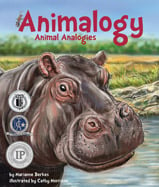Alignment to Standards for MD

| Grade | Number | Standard |
|---|---|---|
| 1 | SC-1.3.0.A.1. | Compare and explain how external features of plants and animals help them survive in different environments. |
| 1 | SC-1.3.0.A.1.b | Compare similar features in some animals and plants and explain how each of these enables the organism to satisfy basic needs. |
| 1 | SC-1.3.0.A.1.c | an organisms external features contribute to its ability to survive in an environment. |
| 1 | SC-1.3.0.A.1.d | Classify organisms according to one selected feature, such as body covering, and identify other similarities shared by organisms within each group formed. |
| 1 | SC-1.3.0.B.2. | Provide evidence that all organisms are made of parts that help them carry out the basic functions of life. |
| 1 | SC-1.3.0.B.2.a | humans and other animals have different body parts used to seek, find, and take in food. |
| 1 | SC-1.3.0.E.1.a | Examine organisms in a wide variety of environments to gather information on how animals satisfy their need for food. |
| 1 | SC-1.3.0.E.1.b | Some animals eat only plants |
| 1 | SC-1.3.0.E.1.c | Some animals eat only other animals |
| 1 | SC-1.3.0.E.1.d | Some animals eat both plants and other animals |
| 3 | SC-3.4.0.A.1.a | Classify objects based on their observable properties. |
| 3 | SC-3.4.0.A.1.b | Provide reasons for placing the objects into groups. |
| 4 | SC-4.3.0.A.1. | Explain how animals and plants can be grouped according to observable features. |
| 4 | SC-4.3.0.A.1.a | a variety of animals or plants in both familiar and unfamiliar environments. |
| 4 | SC-4.3.0.A.1.b | Classify a variety of animals and plants according to their observable features and provide reasons for placing them into different groups. |
| 4 | SC-4.3.0.A.1.c | Given a list of additional animals or plants, decide whether or not they could be placed within the established groups or does a new group have to be added. |
| 4 | SC-4.3.0.A.1.d | Describe what classifying tells us about the relatedness among the animals or plants placed within any group. |
| 4 | SC-4.3.0.C.1.c | some likenesses between parents and offspring are inherited (such as eye color in humans, nest building in birds, or flower color in plants) and other likenesses are learned (such as language in humans ) |
| 4 | SC-4.3.0.D.1.a | Describe ways in which organisms in one habitat differ from those in another habitat and consider how these differences help them survive and reproduce. |
| 4 | SC-4.3.0.D.1.b | Explain that the characteristics of an organism affect its ability to survive and reproduce. |
| 4 | SC-4.3.0.F.1d | Identify and describe the interactions of organisms present in a habitat: Roles within food chains and webs: scavengers, decomposers, producers, consumers. |
| K | SC-K.3.0.A.1.a | features (observable parts) of animals and plants that make some of them alike in the way they look and the things they do. |
| K | SC-K.3.0.A.1.b | features that make some animals and some plants very different from one another. |
| K | SC-K.3.0.A.1.c | Identify a feature that distinguishes animals that fly (as an example) from animals that cannot and examine a variety of animals that can fly to discover other similar features they might share. |
| K | SC-K.3.0.A.1.d | Compare ideas about how the features of animals and plants affect what these animals are able to do. |
| K | SC-K.3.0.A.2.c | similarities in what both humans and other animals are able to do because they possess certain external features. |
| K | SC-K.3.0.D.1.c | Explain that the external features of plants and animals affect how well they thrive in different kinds of places. |
| K | SC-K.3.0.E.1. | Develop an awareness of the relationship of features of living things and their ability to satisfy basic needs that support their growth and survival. |
| K | SC-K.4.0.A.1.b | Based on data, describe the observable properties, such as size, shape, color, and texture of a variety of objects. |
| PK | SC-PK.3.0.A.1.a | how some animals are alike in the way they look and in the things they do. |
| PK | SC-PK.3.0.A.1.d | Identify some of the things that all animals do, such as eat, move around and explain how their features (observable parts) help them do these things. |
| PK-2 | SC-PK-2.1.0.A.1.g | Use whole numbers and simple, everyday fractions in ordering, counting, identifying, measuring, and describing things and experiences. |
| PK-2 | SC-PK-2.1.0.D.3.b | Realize that one way to describe something is to say how it is like something else. |